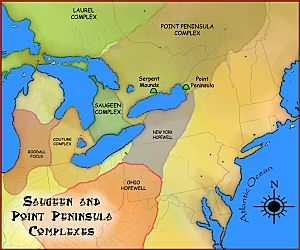Saugeen complex facts for kids

Point Peninsula and Saugeen complexes
|
|
| Period | Middle Woodland |
|---|---|
| Dates | 200 BCE – 500 CE |
The Saugeen complex was a group of Native American people. They lived in what is now Ontario, Canada. Their homes were near the southeastern shores of Lake Huron and the Bruce Peninsula. They also lived around the London area. Some may have lived as far east as the Grand River. These people were active from about 200 BCE to 500 CE.
Archaeologists have found clues that the Saugeen people living on the Bruce Peninsula might have become the Odawa people (also known as the Ottawa).
Contents
Who Were the Saugeen People?
The Saugeen complex refers to a specific culture. It is named after the Saugeen River. We learn about them through the things they left behind. These include tools, pottery, and burial sites.
Daily Life and Community
Archaeological digs suggest that Saugeen groups were fairly small. Each group likely had about 50 people. This size would have been good for hunting and gathering food. They moved around to find resources.
When archaeologists study their sites, they look for clues. So far, they haven't found signs of big differences in status. This means everyone in the group might have been seen as equal.
How Saugeen People Buried Their Dead
The Saugeen people had special ways of burying their dead. Their customs were much like those of the nearby Point Peninsula complex. This suggests they shared some traditions. However, no large burial mounds from the Saugeen complex have been fully explored yet.
Saugeen Pottery and Art
One way to tell the Saugeen people apart is their pottery. Their ceramic pots were often simpler. They were not as fancy or decorated as the pots made by the Point Peninsula complex. This difference helps archaeologists identify their sites.
Connecting with Others: The Hopewell Exchange
The Saugeen people were part of a huge trade network. This network is called the Hopewell Exchange System. It started around 200 BCE in the Ohio and Illinois River valleys. The Hopewell tradition wasn't just one group of people. Instead, it was many different societies. They were all connected by trade routes.
What Was Traded?
The Hopewell trading system was very large. People traded valuable items across long distances. For example, they traded obsidian (a type of volcanic glass) from places like Yellowstone National Park. They also traded copper from the Lake Superior area. Shells from the Gulf Coast were also very popular.
How Far Did the Network Reach?
At its biggest, the Hopewell exchange system was huge. It stretched from the southeastern United States all the way to the southeastern Canadian shores of Lake Ontario. Within this vast area, many different groups traded with each other. The most active trading happened along rivers and lakes. These waterways were the easiest ways to transport goods.

